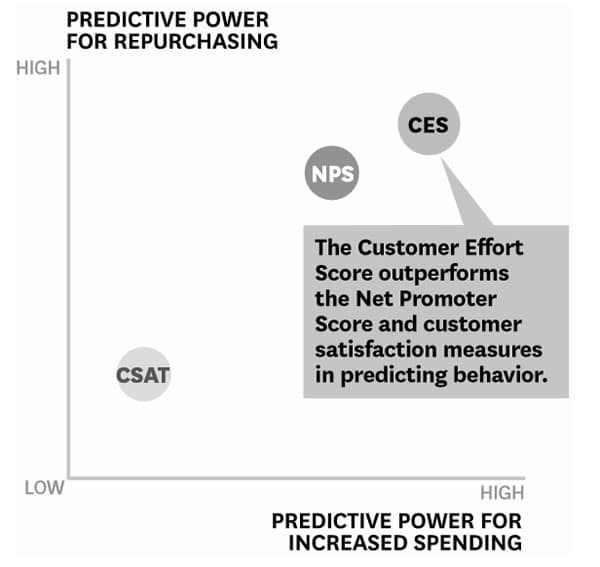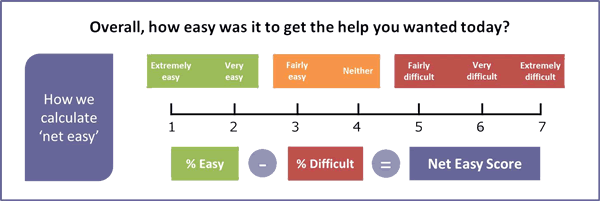Although there is increasing attention for the Customer Effort Score, an “alternative” to the Net Promoter Score, introduced by the CEB (Corporate Executive Board), many questions about it, as well as discussions comparing NPS and CES, remain.
Some say Customer Effort Score is far better to predict customer loyalty while others find it far too vague and useless. So, let’s take a look at CES and an adaptation of it (in practice). The customer experience, contact center and customer service community has been talking about CES for quite some time now and the web is filled with posts about “Customer Effort Score versus Net Promoter Score”. And it all started when a 2010 article/paper in the Harvard Business Review by three CEB directors under the – back then for some quite shocking – title ‘Stop Trying to Delight Your Customers‘ was published.
Yet, the basic premise was pretty straightforward. Essentially the authors said that you don’t necessarily need to satisfy your customers to make them loyal (something NPS “inventor” Fred Reichheld said as well and it keeps popping up in articles emphasizing that satisfaction doesn’t equal loyalty) but that making things easy for customers when it matters makes them loyal as well.
Customer Effort Score: what is it?
The discussions among customer service and customer experience practitioners (not the same either), also revolved around that fact that according to the CEB, Customer Effort Score outperforms NPS (Net Promoter Score) and CSAT (customer satisfaction measures) in predicting behavior, both for repurchasing and increased spending.

Pragmatic as always we see that in reality many customer-centric champions use mixes of various metrics and focus more on context, customer and outcomes than on intellectual debate (which should be held though). Metrics don’t matter as such, the ways you use them and create tangible customer value using them, matter far more.
Why is Customer Effort Score gaining attention
What we also see is that the attention for the Customer Effort Score is growing and that in some situations (for instance, contact centers), there seems to be somewhat of a shift away from NPS and – most certainly – a rapidly growing focus on Customer Effort Score. There are – in our opinion – clear reasons why Customer Effort Score gets so much attention.
Let’s first quickly look at how CES is calculated. Whereas with NPS we ask “how likely are you to recommend“, with CES we ask “how much effort did you personally have to put forth to (handle your request)“, with a score from 1 (none) to 5 (very high) Most critisicm about CES regards the ways we ask customers to rate the effort in relatively vague terms (as you know being very specific when asking people about customer experiences – and anything else- is crucial to avoid misinterpretation as much as possible).
So, why is (the discussion about) Customer Effort Score so popular nowadays? Among the many reasons we see:
The power of simplicity.
The Customer Effort Score focuses on something that is garnering more attention in divisions and functions where it used to be less known or now known at all: customer effort as such, regardless of scores. People who are active in user experience, web usability, marketing optimization etc. have always known how making the experience of people as straight-forward and “easy” as possible is essential.
Removing friction and removing obstacles is crucial, as is ease of use and the role of intuitivity. Today we see this idea, essentially based upon good old “Lean” (a systematic approach of eliminating waste as a management philosophy) is taking center stage in many customer-oriented activities, whereby we can define customers in the broadest sense.
An example: where IT once used to develop applications and employees needed to use them, today employees expect the same ease of use from IT applications as they know it from all the apps out there. This has caused a shift of thinking and working in IT.
The need to cover the basics.
Another phenomenon we see is the increasing awareness that, in this day and age of a holistic approach of an increasingly digital customer and of digital transformation (whereby organizations see how multiple processes, divisions and so on are extremely disconnected), there are gazillions of circumstances where the basics of customer experience and customer service are not covered.
Or in other words: reducing customer effort in a holistic way by focusing on the core tasks at hand as Gerry McGovern showed us with his Customer Carewords® and Customer Top Task Identification approach matters everywhere and is utterly connected.
The relative value of the “wow” experience.
This is somewhat related with the previous point. While there is certainly nothing wrong with delivering “outstanding” customer service and designing for “remarkable” experiences, research in many ares shows that customers de facto simply want to find what they need in a simple and effective way, preferably fast too.
Customer loyalty and relationships.
NPS has been developed from a customer loyalty perspective. The customer life cycle, relationships across the board. However, most customers don’t seek relationships with brands. They just want to perform a task, buy something, get customer service and be left alone for the rest. Of course this doesn’t mean that customer loyalty isn’t important. It would be quite silly to say so. Furthermore, the “relational” dimension has a more important role in some businesses and industries than in others.
The ways businesses use it. As we’ll show in the example below, organizations use Customer Effort Score in adapted ways, supported by decent research and proven results.
In the eyes of the modern beholder – the customer – loyalty becomes somewhat of a thing from the past in an age of (abundant) choice. Admittedly, the role of relationships and loyalty in general has been somewhat overrated in many areas overall. This doesn’t mean they don’t matter but just as customers sometimes don’t seek “experiences”, often they don’t care about loyalty and even more often they don’t want a relationship with you(r) business or brand and whatnot. But again: it all depends on numerous factors.
The Customer Effort Score in practice and in evolution: Net Easy
An example of a company using the Customer Effort Score in a highly pragmatic – and adapted way – is BT.
BT developed an own approach which combines multiple measurements including customer effort for contact centre interactions. The company thereby uses its own Net Easy score which has been adopted by other companies.
Essentially it’s a way to measure how easy customers find it to “interact” with your organization. However, BT found that the way the Customer Effort Score question is asked was too confusing, one of the several criticisms surrounding it. So, instead of asking “how much effort did you personally have to put forth to (handle your request)” with a score from 0 to 5 the company asked “Overall, how easy was it to get the help you wanted today?”. Using customer feedback surveys with answers on a scale from 1 to 7 (1 = extremely easy), the Net Easy score than gets calculated in a similar way as NPS:
% easy – % difficult = Net Easy score.

Looking at the various channels customers use to seek support (including their popularity, cost etc.) and then looking at how easy these channels are in the eyes of customers, companies can find surprising opportunities to put more effort in making specific channels easier.

